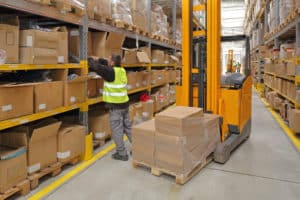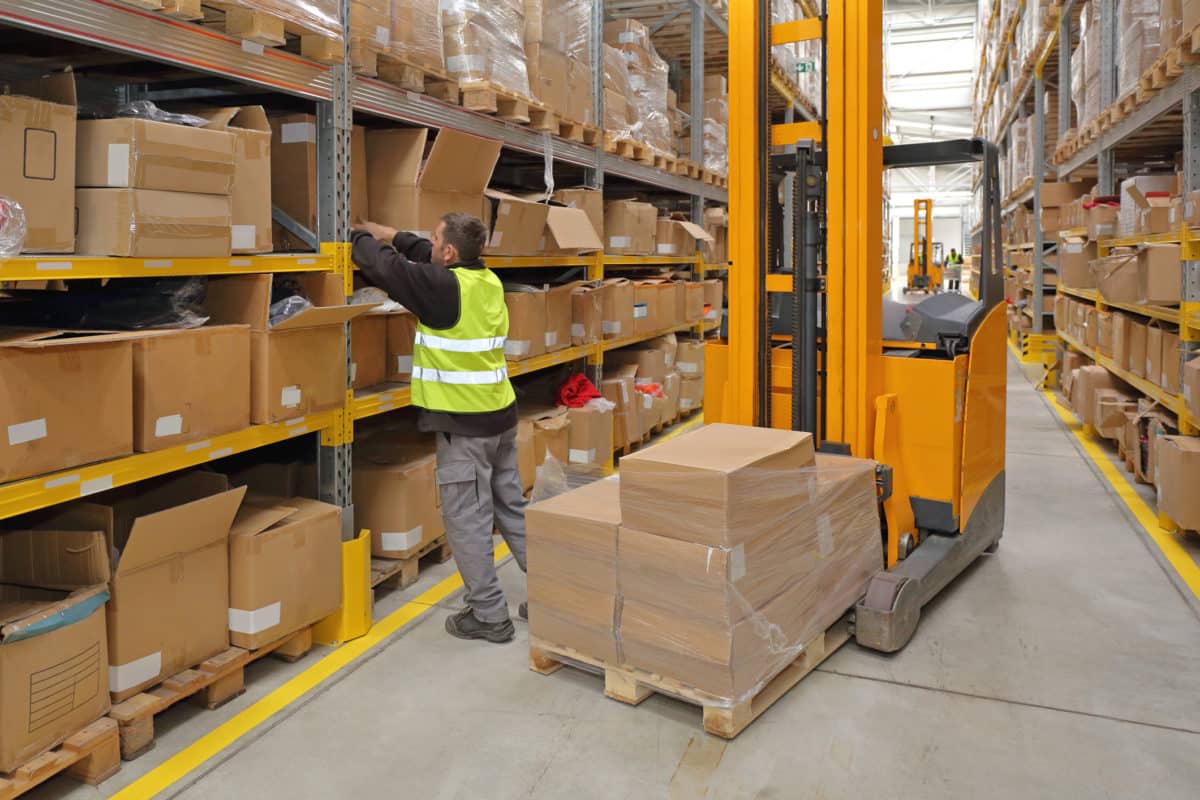
Most eCommerce business owners always look for ways to improve their order fulfillment process.
A recent survey from Logistics Management found that 50-70% of a warehouse’s operating expenses result from order picking activities. This means increasing efficiency in your company’s order fulfillment process can improve your customer satisfaction rates while improving your company’s bottom line.
Customer expectations are rising, and profit margins are becoming tighter. Improving order fulfillment is a high priority for e-commerce businesses, warehouses, and third-party logistics providers. As customer demands increase, many warehouses have begun to rely more on technology, such as inventory management software, to help them streamline their operations and automate their order fulfillment process.
This is the backbone of eCommerce and can make or break your company’s profitability.
That’s why we’ve put together a handy guide to help you streamline your process and make this your most efficient and profitable year.
Here are the ten steps to improving your order fulfillment process:
-
- Understand your order fulfillment cycle time
- Minimize warehouse staff decisions
- Use inventory classification
- Differentiate between quotes and orders
- Keep enough inventory on hand
- Incorporate Multi-location Management and Support
- Streamline Inventory Processes
- Increase transparency
- Offer Options for Viewing and Updating Pick Lists
- Increase Picking Accuracy
Understand your order fulfillment cycle time
You can’t improve what you don’t measure. Your order fulfillment cycle time is the time it takes from when an order is placed until it’s delivered to the customer. This is also often referred to as throughput time.
Your goal is to minimize this time as much as possible so that your customers are happy and become repeat business for you.
There are a few things you can do to help shorten your cycle time:
- Make sure you have enough staff on hand to handle the volume of orders.
- Streamline your processes so that there are no bottlenecks
- Keep an eye on your inventory levels so you’re never out of stock. Use a safety stock formula to ensure proper inventory levels.
By understanding and optimizing your order fulfillment cycle time, you’ll be able to keep your customers happy and your business running smoothly.
Minimize warehouse staff decisions
When looking for ways to minimize costs and increase efficiency, try reducing the number of decisions your warehouse employees have to make.
Every time an employee has to stop and make a decision, it slows down the fulfillment process and increases the chances of errors.
One way to accomplish this is to invest in an automated order picking system. These systems use technology to track inventory and select the most efficient route for each order, typically with wave picking.
As a result, your employees can follow the instructions provided by the system, minimizing the need for them to make decisions along the way.
Another way to reduce decision-making is to streamline your receiving process. For example, by implementing a barcode inventory system, your employees can quickly scan and track incoming inventory.
Investing in some key technologies can help minimize decision-making in your warehouse and improve your overall order fulfillment process.
Use Inventory Classification
Using inventory classification, or dividing your inventory by category, can help your business efficiently fulfill your most popular product orders.
For example, online bookstore owners might notice that mysteries sell faster than autobiographies. To meet customer demand, these owners must re-order mysteries more frequently and in larger quantities. They also want to place your most popular categories closer to the shipping station in the warehouse. That way, there is less distance between picking and packing for more popular sellers than slower selling categories.
Differentiate between quotes and orders
A quote is an estimated price for a product or service. However, it is not a final price. Many businesses offer quotes to prospective customers to give them a general idea of what a product or service will cost.
While a quote may be subject to change based on extenuating factors, most customers expect the final bill will be at or under the quoted price.
Additionally, the customer is not obligated to utilize your services or buy your product simply because you have provided them with a quote.
An order is a contract between your business and your customer that outlines the products or services you will provide them in exchange for a specific price. The order may also include additional conditions such as delivery dates, down payments, or financing options agreed to by you and your customer.
Keep enough inventory on hand
Stock-outs cost you money in terms of lost sales and frustrated customers.
That’s why it’s critical to always keep enough inventory on hand to meet customer demand. You can stay on top of your inventory needs by utilizing a demand forecast, which is often available via your inventory management software.
You’ll need to keep a close eye on your inventory levels, including quantity and other factors such as expiration dates, to ensure you always have the stock you need to fulfill your customers’ orders.
You’ll also want to ensure that you frequently communicate with your suppliers and sales team to have all the information you need to ensure your items are always in stock.
Incorporate multiple warehouse location management and support
Multiple site inventory management and support enable your employees to track inventory and fulfill orders from various warehouse locations. For example, suppose an order comes in for five chessboards, and you have three at a warehouse in Texas and another four at a warehouse in Virginia. In that case, multi-site support lets you understand where your stock is and how best to get it to your customer.
This enablement and support are critical when you have multiple sales channels, such as an online store, a brick-and-mortar store, and one or more warehouses where inventory is stored.
Multi-location inventory management software typically integrates with your eCommerce platform and accounting software. This gives you a complete picture of your company-wide inventory levels, sales, and profitability. Multi-location inventory management software can also help you to track your inventory in real-time, so you always know what’s in stock and where it’s located.
Some of the benefits of using multi-location inventory management software for your eCommerce business include:
- Accuracy in inventory levels across locations
- The ability to track inventory in real-time
- Improved fulfillment efficiency
- Reduced costs associated with overstocking or understocking inventory
- Increased profits due to more accurate pricing company-wide
Streamline inventory processes
One of the most effective ways of improving your company’s order fulfillment is to streamline your inventory processes by automating the systems you already use. Software tools can manage multiple stages of your order fulfillment process, saving you time and money.
An efficient inventory management system will automate monitoring stock levels, ordering new supplies, and managing vendor relations. It can also provide real-time data to help you make better decisions about production levels and purchasing.
In addition, an automated system can generate reports that give you visibility into your entire operation, so you can identify areas where you can improve.
Consider investing in an automated system to streamline your inventory management and improve your order fulfillment. It can save you time and money while making your operation more efficient.
Increase inventory transparency
When you have multiple sales channels, it is critical to have transparency throughout your organization. Across every channel and division, your employees should have access to information about your inventory levels, customer communications, supplier activity, as well as overall sales.
Increased transparency throughout your organization helps ensure that your order fulfillment is accurate and your customers are satisfied.
In addition, company-wide transparency speeds up the order fulfillment process by helping to eliminate hiccups along the order fulfillment journey.
Offer options for viewing and updating pick lists
Modern technology allows you to avoid expensive errors by providing your customers with the opportunity to view or print pick lists.
These options not only serve the customer, who can update the pick list up until the time of packing, as well as the picker, who can double check orders to ensure accuracy — right from their mobile phone.
This means a customer who wants to add another item to their order after checkout can do so, and you can still ship everything together to cut down on shipping and packaging costs.
Increase picking accuracy
An important metric for any warehouse or distribution center is picking accuracy. This number lets you know how often the correct item is picked from inventory and shipped to the customer. An effective way to improve your business’s picking accuracy is by optimizing your picking system, which can be done in a few different ways.
First, make sure that all items in your inventory are correctly tagged. This will allow you to locate and track items more efficiently using a WMS.
Second, take advantage of technology such as barcode scanning. This will improve accuracy rates whether you’re using a manual or automated picking system.
Third, train your employees on proper picking procedures. This will help to ensure that items are picked correctly and efficiently.
Lastly, consider adding a QA portion to your shipping process where items are either checked as they are picked or before packaging to ensure accurate picking.
Following these steps can improve your business’s picking accuracy, lower labor costs, and increase customer satisfaction.
Frequently asked questions about improving order fulfillment
What are the six steps in the order fulfillment process?
Here are the six steps in the order fulfillment process to ensure each order is fulfilled promptly and correctly:
- Receive the order: When you receive an order, ensure it’s processed correctly.
- Pick and pack the items: Once the order is received, you’ll need to pick and pack the items for shipment.
- Generate a shipping label: Once the items are packed, you’ll need to generate a shipping label so the order can be shipped.
- Ship the order: This is where the order leaves your hands and heads off to the customer. Make sure it’s properly labeled and packaged so it arrives safely.
- Send tracking information: Once the order has shipped, you’ll need to send tracking information to the customer so that they can track its progress.
- Update the order status: Finally, you’ll need to update the order status in your system so the customer can see that their order has shipped and ultimately delivered.
How can outsourcing improve the order fulfillment process?
One way to improve the order fulfillment process is to outsource some or all of it. Outsourcing allows eCommerce businesses to tap into a larger pool of resources and expertise, which can lead to more efficient and effective order fulfillment.
Specifically, the significant benefits of outsourcing your order fulfillment process are improving your picking accuracy, increasing your picking speeds, and reducing your labor costs. All of these improvements can lead to increased customer satisfaction and loyalty.
If you are considering outsourcing order fulfillment, there are a few things to keep in mind. First, you will need to choose the right provider. There are many order fulfillment providers out there, so it is essential to do your research and find one that is a good fit for your business.
Another thing to keep in mind is that you will need to have a good understanding of your own order fulfillment process before you outsource it. This will help you communicate your needs to the provider and ensure that they are able to meet your specific requirements.
Outsourcing your order fulfillment can also help eCommerce businesses to free up internal resources that can be better used elsewhere in the company.
If you take the time to find the right provider and prepare for the outsourcing process, you can reap the many benefits that outsourcing can offer.
Order fulfilment next steps
Improving your order fulfilment process can seem daunting, but it is one of the most effective ways to improve your company’s bottom line.
You can streamline your entire process by understanding your order fulfillment cycle time, minimizing warehouse staff decisions, using inventory classification, keeping enough inventory on hand, and incorporating multi-location management and support.
Increasing transparency and picking accuracy and speed are critical goals to keep in mind as you work to improve your fulfillment process.

